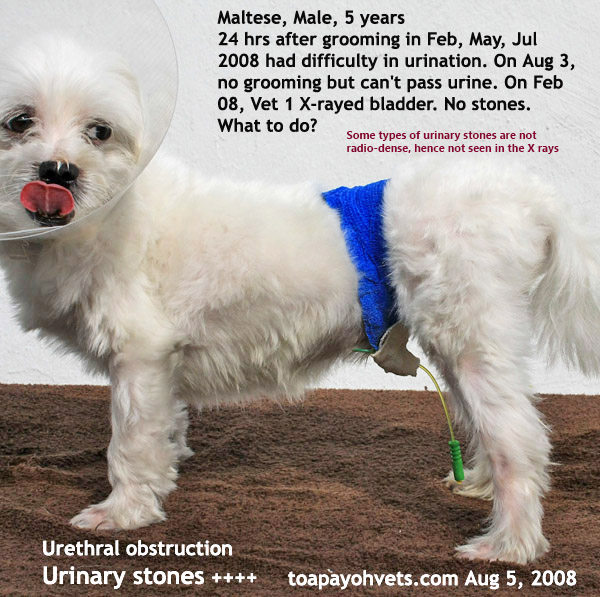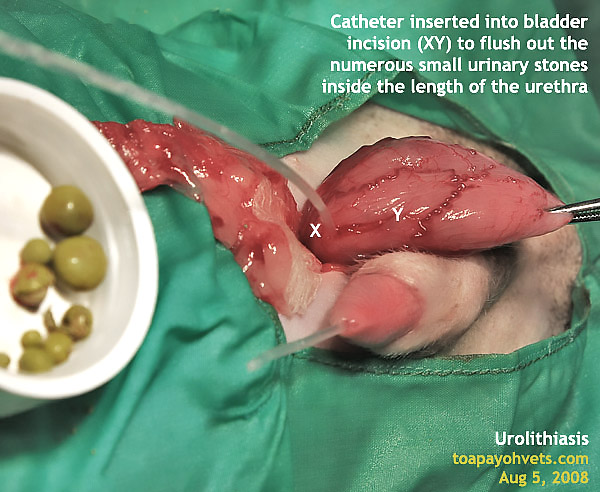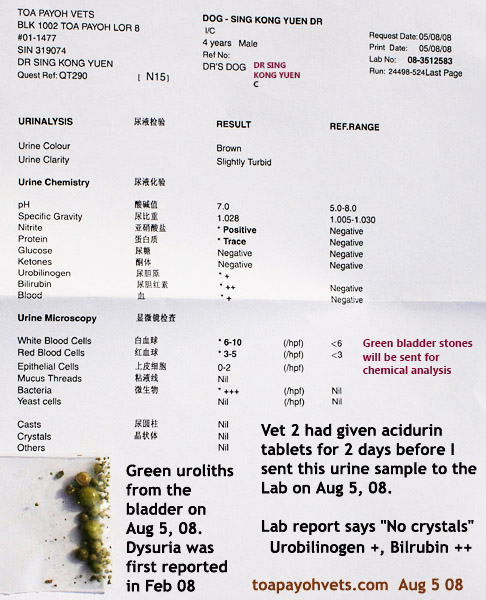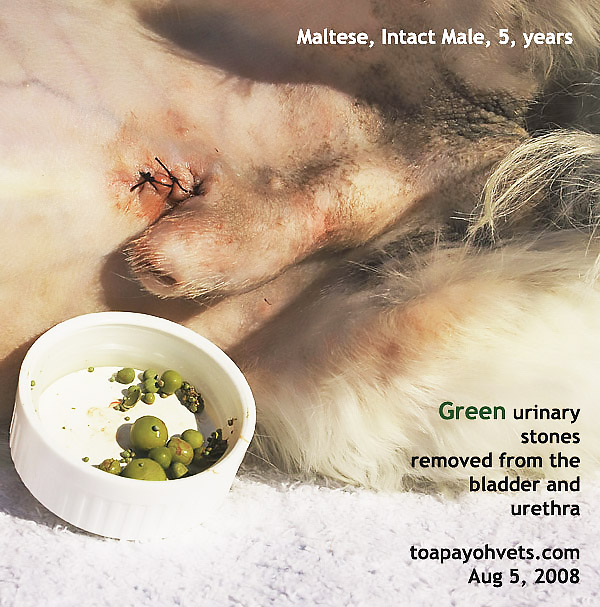"If your car can't move after returning from the mechanic, what do you expect?" the trim man in his 60s asked me as I was about the leave the Surgery at the end of a long day. Without waiting for my reply, Mr Lee said, "Surely you expect the mechanic to repair your car till you can drive it. Free of charge."
A veterinarian who had warded his dog for 3 days had released the dog to him. "Look, look, no urine came out," the man directed my attention to the small mini-Maltese cocking his right leg against the wall of a column for a few seconds."
"This is the first time I see your dog. I don't know anything about your dog treatment," I said, not wanting to get involved with potential litigation. "You will have to talk to your vet." I went back to the Surgery to collect my things.

Mr Lee knocked on the glass panels in front of the Surgery to attract the attention of Mr Saw, my vet technician who was at the waiting area doing some administration work. "Ta boleh kenching (Cannot urinate in Malay)," he cricked his knucles onto the glass panels and shouted from outside.
I went out of the Surgery: "No point talking to Mr Saw. He is not a veterinarian in Singapore. He does not speak the Malay language. He is a Myanmarese." Mr Saw had been mistaken for an Indian and now as a Malay as he has sunburnt tanned skin.
If possible, I would help to resolve any dispute affecting the veterinary profession even if the veterinarian is from the competition. I spent some time finding out what Mr Lee wanted.
"All my money back," he said. "After all, the dog still cannot pee and I still paid the fees. If your car goes to the mechanic and he cannot repair your car, you ought to get your money back."
Mr Lee went on about the roles and responsibilities of the mechanic. Non performance, money back guarantee.
"Well," I said. "You really have to speak to your vet directly if you want your money back. He had done a lot of work. I don't know what really happened."
Mr Lee said, "I understand that this vet had a business to run and has his overheads." He waved a veterinary bill for me to see, "I don't know whether he had really given the drugs or treatment to the dog. Vet 1 (the first vet) who treated him had said there was no bladder stones and after his X-ray, the dog could pee normally for some weeks. On another occasion, I went to Vet 1 and he prescribed some antibiotics without seeing the dog. The dog could pee normally. Last week Vet 1 refused to give me the antibiotics. He wanted me to bring the dog down for examination. I came to consult Vet 2 because he is nearer to my home."
I had no comments about the actions of Vet 1 and 2 and should not comment on professional matters I had no idea about.
I said, "Mr Lee, how much money do you want back from Vet 2?"
"All my money," Mr Lee said. I shook my head, "Vet 2 had spent time and did work on your dog. I don't know what he advised you. The only thing I can do for you is to phone him and ask him for some money back for you."
Mr Lee nodded his head.
Vet 2 said to me when I phoned, "Mr Lee had contacted me some 20 times. The dog has urinary stones and need a cystotomy."
"Can you give him back some money so as to resolve the matter?" I asked. "Negotiate."
Vet 2 said in some serious tone, "I am non-negotiable."
I focused him on the problem of money without wasting time on listening to his treatment because it was none of my business. Mr Lee wanted was "money back".
"Negotiation is the best way in this case. Give Mr Lee a counter-offer," I urged Vet 2. My experience in Singapore real estate helps me a lot in matters of negotiation in sales and purchases of houses.
"This dispute can be resolved with money and you will never see Mr Lee again." I advised. I did not want to say much about the ugliness of veterinary investigation by the authorities and prospective litigation as all veterinarians in practice would have had suffered some time or another. I presumed Vet 2 had never encountered such ugliness personally.
However, giving money back is perceived by some owners to admission of guilt or negligence. So, if Vet 2 stood his ground, I could just go home. Still I talked to Vet 2 to advise him to give back some money to avoid all unpleasantness and paperwork of veterinary investigation and litigation. It would cost more than $1,000 to engage a lawyer to defend Vet 2 and how about the tremendous amount of time involved in case writing?
Here we are talking of giving back around $100 back to the owner.
"50% back," Vet 2 said. I conveyed the message to Mr Lee. "80%," Mr Lee said. I asked Mr Lee to sit on the chair and talked to him. "Vet 2 had told you that your dog had bladder stones. Even though Vet 1 had said there were no bladder stones some months ago and that antibiotics cured the dog, it is Vet 2's diagnosis that the dog has bladder stones. Veterinary surgery for bladder stone removal and other tests would be expensive."
Mr Lee did not wish to proceed further with surgery, "I sell this dog to you,"
"I am sorry to say that a 4-year-old mini-Maltese has no commercial value," I said. "As a puppy he might sell for $800 but once adult, very rarely will anybody pay to buy him."
Lots of talking proceeded. "Veterinary expenses for a dog is much lower than bringing up a child," I said. "When children grow up, they don't pay the parents back the large amounts of money spent on educating them. They have their families to support and so do not give any allowance to their parent. Is that right, James?"
James is a 73-year-old working as a receptionist for me. James nodded his head.
"No, no" Mr Lee disagreed, shaking his head vigorously. "My son gives me money." He took out a worn out name card of his son who had worked for a foreign multi-national bank. Then another card of his new job with a premier financial institution."
"You are one fortunate father," I said. It was past 7 p.m. A lady in shimmering brown dress and high heels was seen at the glass panels of the entrance. She walked in.
"Look at this pretty lady," I pointed to the young woman well dressed and in the prime of her life. "Her dog had urinary stones and could not pass urine 2 months ago. Then after the operation, the dog could not pass urine 3 days ago. Now she is taking her dog home from the Surgery. She spent a lot of money on treating him and he might have problems not able to pee again."
I gave some instructions to the young woman as to how to care for her Miniature Schnauzer. She rolled her eyes upwards as she read a long lists of what to do to prevent recurrence and to give prescription diets on medical dissolution of the struvite stones.
Mr Lee was watching intently. She paid around $600 inclusive of the X-rays and 20 cans of prescription diet. On paper, it seemed that $600 was for 3 days of warding and treatment at the Surgery by me. What a large amount for a dog that can't pee again.
From Mr Lee's encounter, I asked the young woman to put the dog down on the grass to see whether he could pee normally or not. The Schnauzer sniffed here and there. After one minute he wandered further away and the young lady followed him.
"He peed normally," the young lady said as it was too dark for Mr Lee and I to see. It was nearly 7.30 p.m.
"Do you want this Maltese?" I asked the young lady. You need to get this dog surgery tor remove his bladder stones."
"I have 3 dogs," she said. "I can't take this one."
Mr Lee decided to give me his Maltese. No point throwing good money after bad, in a case of a Maltese that now had problems. Now, what to do with this dog? Nobody wants him. Euthanasia is the only option.
UPDATE AS AT AUGUST 9, 2008.The urinary stones in this Maltese can be removed by surgery. However, there is no guarantee that he will not get a similar problem another time. X-rays after the surgical removal of stones and every 3-6 months are ideal. 2-weekly urine tests for the next 3 months are recommended to check for bacterial infection and the pH of the urine. Absence of crystals in the urine as in this case (urine sent for checking prior to surgery) do not mean that the dog has no stones (>100 numerous green ones).
SURGERY ON AUGUST 5, 2008
1. General anaesthesia. IV drips.
2. Skin incision cranial to prepuce
3. Linea alba incised
4. Bladder hooked out or use forceps. Bladder was empty.
5. Ventral surface of the bladder was incised, between large blood vessels seen on the bladder wall.
6. Forceps to pick out as many stones as possible, esp. large ones.
7. Insert catheter into urethra to bladder.
8. Flush 20 ml of Hartmann's solution via catheter into bladder. More stones are flushed out. Repeat.
9. Clamp incision with forceps and flush Hartmann's solution to distend bladder.
10. Release forceps to let stones flush out. Numerous sandy ones. Repeat.
11.Insert catheter via bladder to urethra and flush stones along the length of the urethra out. Numerous small sandy ones.
12. 2 layers of inverting stitches 3/0 dissolvable. Not to stitch into mucosa.
Mucosa looks white. Bladder wall is thickened.
13. Flush 10 ml of Hartmann's solution into bladder via catheter. No leakage seen as bladder distends. Repeat.
14. Close skin.
15. Collar. No need catheter.
16. Dog is normal as at August 9, 2008. No problem peeing. Eating well.
URINE ANALYSISUrine was sent to the laboratory for analysis prior to surgery.
No crystals in the urine in the report. No crystals do not mean that there are no urinary stones! Many stones.







































